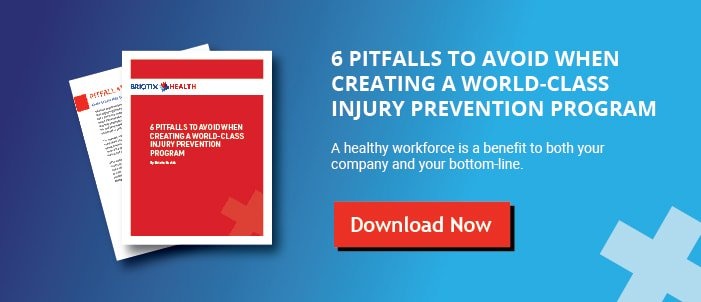Carpal tunnel is one of the most common repetitive stress injuries facing workers today, with the CDC reporting an average of about 900,000 new cases in the US annually. In some cases, carpal tunnel can be attributed to working conditions, opening up employers to compensation claims. However, as there are many different factors which can cause carpal tunnel syndrome, the burden of proof rests heavily on employees to prove their injury is the result of their working conditions. Once you are aware of these factors, you can minimize them in your own organization.

When Should an Employee File a Workers Comp Claim for Carpal Tunnel?
The wrist is one of the most flexible joints in the human body, but it is formed by a delicate network of bone, muscle, tendons and ligaments. While offering great mobility, this complexity makes the wrist vulnerable to sudden injuries or stress disorders which may occur over time. One of the most common is carpal tunnel syndrome (CTS), which occurs when physical activity stresses the ligaments in the wrist. This causes them to inflame and compress the median nerve, which runs between them in a space known as the carpal tunnel.
Related: Reduce Your Risk of Carpal Tunnel With 3 Easy Steps
One of the most common symptoms of carpal tunnel syndrome is a tingling or burning sensation in the hand, which may be temporary or long-term. Other common symptoms include:
- A weak grip or wrist
- Clumsiness
- Pain that stays throughout the day or which begins at night
If left untreated, CTS can cause:
- Muscle atrophy
- A loss of mobility
- Permanent damage to the median nerve (in some cases)
However, carpal tunnel generally responds well to nonsurgical treatments if caught early.

An employee should file a worker’s compensation claim for carpal tunnel if they have strong evidence that it was caused by their occupation. However, it can be difficult to prove this once lifestyle factors are taken into consideration. Any of the following can induce CTS:
- A second job that also requires repetitive movements
- Sporting or musical activities
- Diabetes or rheumatoid arthritis
- Sudden injury
State laws may vary on whether CTS is to be treated as an injury or an illness, which means workers should only file a workers compensation claim if they have a convincing case that it was caused by their occupation.
When Can Carpal Tunnel Be Considered Work-Related?
Workers have the best chance of obtaining compensation for carpal tunnel syndrome if their normal work duties place large amounts of stress on the wrist. This can come through either repetitive or awkward motions or through use of high-powered vibrating equipment. CTS is commonly associated with factory workers, data entry clerks or typists, and others who work with computers. However, it’s also highly prevalent among grocery store workers and butchers, grinders, and frozen food factory workers.
A business may be held responsible for compensating a worker with CTS if it is found their normal duties or unsafe work conditions led to its onset. Workers in sectors that tend to experience rates of CTS higher than the general public are more likely to be able to file a successful claim for CTS. However, some carpal tunnel cases are idiopathic and are not related to the workplace, even if they occur in industries with a higher prevalence of the condition. Ultimately a judge will decide each claim based on the evidence a worker presents.
Related: How Onsite Physical Therapists Help Cut Workers Compensation Costs
How to Prove Carpal Tunnel Is (or Is Not) Work-Related
Given the wide range of environmental and biological factors that can cause carpal tunnel syndrome, it can be hard for workers to prove it came from their job. This can be especially difficult if they began experiencing CTS after they left the position they felt caused it. Workers may also face different standards for proving their CTS was the result of their employment, presenting another hurdle. However, if they can make a compelling argument that their employment was the source of their CTS, they stand a good chance of winning compensation.
In cases where states treat CTS as an occupational illness, workers will need to provide much more evidence to obtain compensation than they would if they could claim it as an injury. They will need to show that their normal work duties made them susceptible to CTS and that their lifestyle choices did not unduly contribute to its onset. In some states, workers that do experience CTS after only a few months or even years on the job may be found to have a pre-existing condition and won’t qualify for compensation.

Workers may have an easier time winning a worker’s compensation claim for carpal tunnel if they can show they got it through an injury on the job. They may be able to point to a particular instance which caused it which could be well-documented, both inside work and with a doctor. States that categorize CTS as an injury also generally only require a “preponderance of evidence” in order for employees to win their claims, which is a lower threshold than that required in places where it is categorized as an occupational illness.
What Is the Average Payout for Carpal Tunnel Workers Comp Claims?
State laws regarding the carpal tunnel syndrome are highly variable, meaning local factors will heavily influence the ability of employees to seek compensation for their claims. In addition, no two cases of carpal tunnel compensation are alike, which means the amount employees can settle for falls across a wide range of potential values. A compensation claim may take into account past or future lost wages depending on how severely the disease affects a worker’s livelihood. Some employees require only time off to recover, while others require costly surgeries, which may be covered by the employer.
If you think your business will face a successful carpal tunnel claim, it helps to keep a few stats in mind. Amino reports that the average carpal tunnel release surgery costs $2,922, but prices ranged anywhere from $1,811 to $5,413 depending on location. According to a 2006 study published in Occupational Medicine, most workers take about three weeks to recover from the surgery, but in exceptional cases the recovery time can take months. However, Health.com reports nonsurgical treatments can cost $300 or less, making prevention far less expensive than the cure.
Carpal Tunnel Syndrome Workplace Adjustments to Implement Today
If your workplace produces high rates of carpal tunnel syndrome, here are a few practices you can quickly implement to help reduce the number of cases:
- Conduct an ergonomic assessment to determine potential sources of injury
- Replace old equipment that can lead to stress-related injuries
- Institute more or longer rest periods for workers engaged in repetitive tasks
- Train employees to work in ways that limit stress placed on their bodies
- Begin employee exercise programs that strengthen vulnerable muscles and joints
Carpal tunnel syndrome can be costly and destructive to workers and businesses, but in many cases it is easily avoidable if you adapt your business to the human body. By making your workplace more ergonomic, you can reduce or eliminate sources of repetitive stress or sudden injury associated with CTS. This can save your business money while also increasing overall productivity, as workers take less sick days, face fewer injuries, and can complete their tasks much more easily. An investment in ergonomics can improve not only the health of your workers, but that of your business as well.
